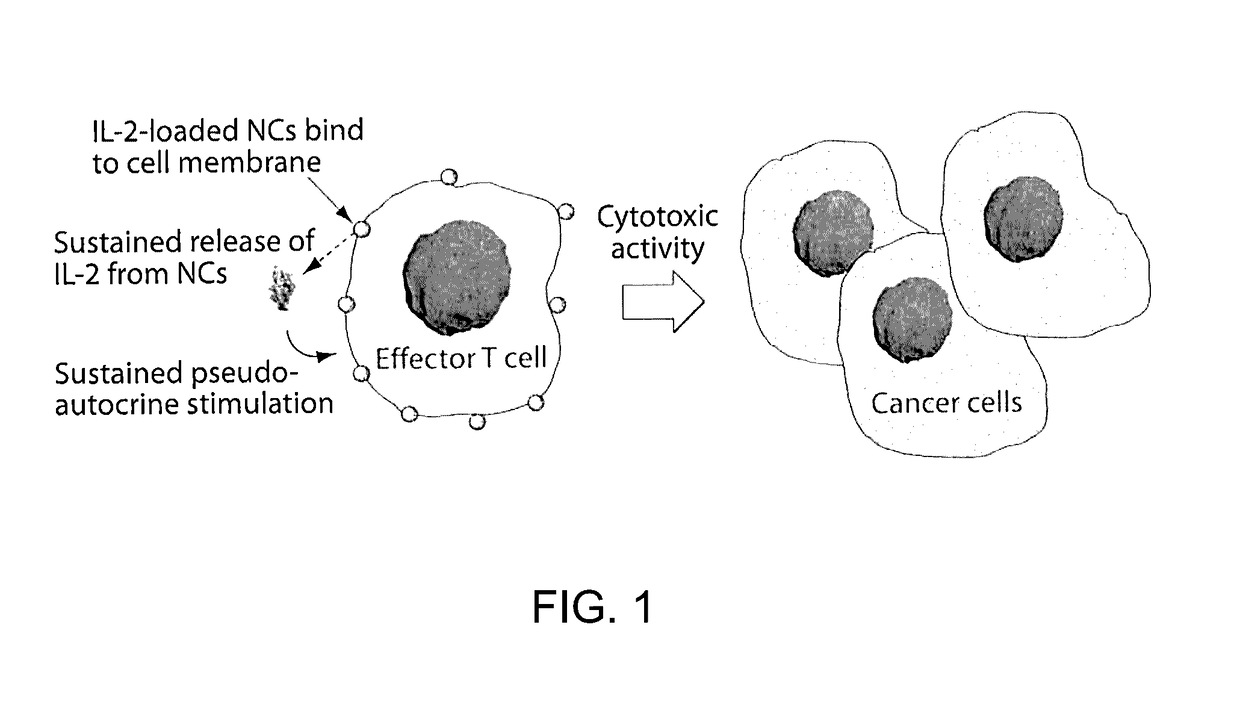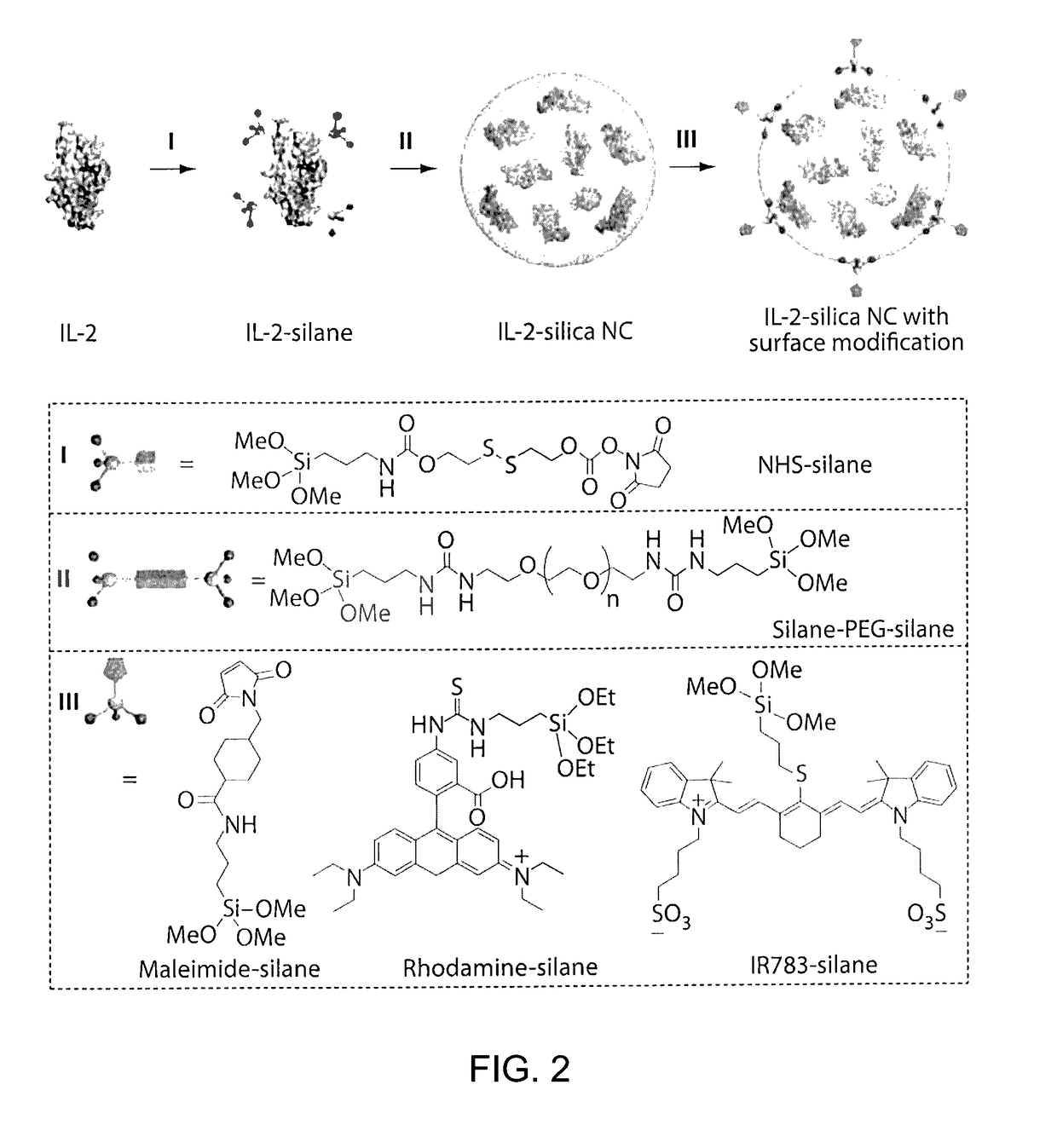Carrier-free biologically-active protein nanostructures
a carrier-free, biologically active technology, applied in the direction of peptide/protein ingredients, immunological disorders, metabolism disorders, etc., can solve the problems of reducing the bioactivity of conjugated proteins, limiting the use of protein therapeutics, and inefficient encapsulation or adsorption of proteins in/onto liposomes or nanoparticles, etc., to achieve high protein drug loading efficiency and high incorporation efficiency
- Summary
- Abstract
- Description
- Claims
- Application Information
AI Technical Summary
Benefits of technology
Problems solved by technology
Method used
Image
Examples
example 1
[0158]In the context of adoptive T cell therapy for cancer treatment, adjuvant cytokine drug, IL2, provides key adjuvant signals to donor T cells but also elicits severe dose-limiting inflammatory toxicity and expands regulatory T cells (Tregs). Provided herein is a delivery method to safely and efficiently target IL-2 to therapeutic cells with minimal toxicity.
[0159]FIG. 1 illustrates an example of a method of preparing protein-silica nanocapsules (NCs). Polymerizable silane groups were first conjugated to IL-2 through a redox responsive linker (Formula I) to prepare IL-2-silane (FIG. 2, I). The modified IL-2 was further reacted with (3-Aminopropyl)triethoxysilane to functionalize IL-2 with polymerizable silane group on the protein surface. Subsequent polymerization of the silane groups together with a crosslinker (e.g., silane-PEG-silane, FIG. 2, II), catalyzed by NaF, resulted in the proteins being wrapped in a degradable silica nanocapsules (NC), which efficiently protects the p...
example 2
[0167]Linker-1 was first conjugated to the end of a 4 arm-PEG polymer chain (FIG. 8A). A subsequent crosslinking reaction of 4 arm-PEG-Linker-1 and IL-2-fc in PBS buffer resulted in protein-PEG nanogel particle formation (FIG. 8B), which efficiently protects the protein from degradation in physiological conditions. Upon reductant dependent cleavage of the linker between the protein and PEG in physiological conditions, the protein is released to its original form.
[0168]Methods
[0169]FIG. 8A: Synthesis of 4 arm-PEG-Linker-1. 4 arm-PEG-NH2 (10 mg) dissolved in 300 μL tetrahydrofuran (THF) was added drop-wise to an 800 μL THF solution of Linker-1 (17.4 mg, 40 equiv.) and triethylamine (5 μL). The mixture was further stirred at room temperature overnight. Four-arm-PEG-Linker-1 was purified by dialysis (molecular weight cutoff=3,000 Da).
[0170]FIG. 8B: IL2-fc-PEG nanogel particle formation. IL-2-fc (50 μg) was mixed with 4 arm-PEG-Linker-1 (15 μg, 3 equiv.) in 100 μL PBS buffer and rotated ...
example 3
Preparation and Characterization of Protein Nanogel (NG)
[0172]As shown in FIG. 9, IL2-Fc (100 μg) was mixed with a disulfide crosslinker (4.36 μg, 10 equiv.) in 10 μL of phosphate buffered saline (PBS) and incubated at room temperature for 1 hour (h). The resultant IL2-Fc-crosslinked nanogel was washed with PBS (0.4 mL×3) using Millipore Amicon ultra-centrifugal filter (molecular weight cutoff=100,000 Da) to remove unreacted IL2-Fc and / or unreacted disulfide crosslinker. The IL2-Fc-crosslinked nanogel was then PEGylated by mixing the IL2-Fc-crosslinked nanogel with 4 arm-PEG10k-NH2 (FIG. 9A; 50 μg, 5 equiv.) in 100 μL PBS buffer. The mixture was incubated at room temperature for 0.5 h. The PEGylated IL2-Fc-crosslinked nanogel was then washed with the ultra-centrifugal filter. The incorporation efficiency of IL2-Fc was determined by centrifuging down the PEGylated IL2-Fc-crosslinked nanogels and measuring the concentration of IL2-Fc in the supernatant.
[0173]The PEGylated IL2-Fc-cross...
PUM
| Property | Measurement | Unit |
|---|---|---|
| diameter | aaaaa | aaaaa |
| diameter | aaaaa | aaaaa |
| diameter | aaaaa | aaaaa |
Abstract
Description
Claims
Application Information
 Login to View More
Login to View More - R&D
- Intellectual Property
- Life Sciences
- Materials
- Tech Scout
- Unparalleled Data Quality
- Higher Quality Content
- 60% Fewer Hallucinations
Browse by: Latest US Patents, China's latest patents, Technical Efficacy Thesaurus, Application Domain, Technology Topic, Popular Technical Reports.
© 2025 PatSnap. All rights reserved.Legal|Privacy policy|Modern Slavery Act Transparency Statement|Sitemap|About US| Contact US: help@patsnap.com



